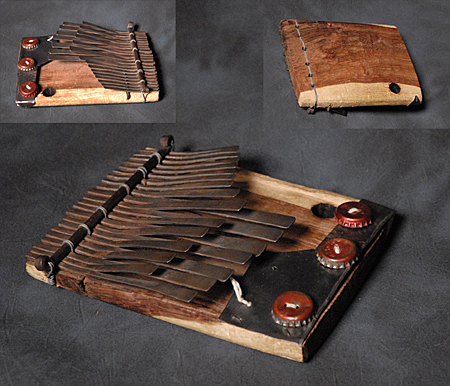
Owner: HWMC
Catalog#: AF-IDPL-28-14
Lamellophones
Shona 'Mbira dza vadzimu' (B)
Zimbabwe
Shona
Wood, metal bottle caps, metal,
Mid 20th Century – Collected in 1960’s
Length: 10 inches
Idiophone – Lamellophones – Plucked
This mbira has a solid wood soundboard with a fingerhole drilled into its bottom right-hand corner. There is a double row/rank of 22 keys (lamellae). Each key is wider and thinner at its sounding end than at its anchored end. These keys are anchored or held in place with a metal pressure bar. Three bottle caps are loosely attached to the metal on the metal bottom rim, which serves as its buzzing mechanism. The mbira dzavadzimu is typically wedged into a deze, a large hemispheric gourd resonator which greatly increase the volume of the mbira dzavadzimu.
The mbira dzavadzimu (‘mbira of the ancestors’), is also known as the nhare mbira (‘iron mbira’). It is a plucked lamellaphone idiophone of the Zezuru Shona people of Zimbabwe. This instrument is closely associated with traditional spirit possession ceremonies. These ceremonies, known as bira, are the primary context in which the mbira dzavadzimu is played, but it also has come to be incorporated in other settings more secular in nature. In recent decades, this instrument has become the most widely known form of Zimbabwean lamellaphone. This rise to prominence is often associated with the surge in nationalism that led to the Zimbabwean independence struggle of the 1970s. Music played on the mbira dzavadzimu became a source of nationalistic pride and came to index indigenous identity. The secularization and popularization of the mbira dzavadzimu continued after the independence movement as popular music groups began to incorporate traditional musical instruments and styles into contemporary musical forms. This synthesis of traditional and popular music was most notably done by Thomas Mapfumo. As the focus of scholarly writings and recordings published by American ethnomusicologist Paul Berliner in the 1970s, the mbira dzavadzimu came to the attention of an international audience.
Source: mbira dzavadzimu · Grinnell College Musical Instrument Collection · Grinnell College Libraries
